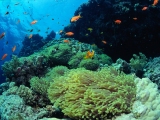Wednesday, August 22, 2007
New Scale Developed to Diagnose Decompression Sickness
Researchers at the Hyperbaric Medicine Department, San Diego, have developed a three-point scale to diagnose decompression sickness.
There are currently no universally accepted diagnostic criteria for the diagnosis of decompression sickness. The new SANDHOG (SAN Diego Diving and Hyperbaric Organizations) criteria uses a point scale and entrance level for the diagnosis of decompression sickness. Once the entrance criterion has been met, points are awarded based upon the diver's symptoms and their time of onset.
The point system and time limits were determined based upon US Navy and Royal Canadian diving reports.
On validating the SANDHOG criteria against a database of diving related injuries, the researchers found that the specificity of the SANDHOG criteria to be good, and concluded that the SANDHOG criteria are a useful tool for the diagnosis of decompression sicknes.
Journal Reference: Undersea Hyperb Med. 2007 May-Jun;34(3):199-210.
What do you think of this news item? Start a discussion.
Bookmark with: del.icio.us | Digg | Newsvine | NowPublic | Reddit
--
Subscribe to SCUBA News (ISSN 1476-8011) for more free news, articles, diving reports and marine life descriptions - http://www.scubatravel.co.uk/news.html

There are currently no universally accepted diagnostic criteria for the diagnosis of decompression sickness. The new SANDHOG (SAN Diego Diving and Hyperbaric Organizations) criteria uses a point scale and entrance level for the diagnosis of decompression sickness. Once the entrance criterion has been met, points are awarded based upon the diver's symptoms and their time of onset.
The point system and time limits were determined based upon US Navy and Royal Canadian diving reports.
On validating the SANDHOG criteria against a database of diving related injuries, the researchers found that the specificity of the SANDHOG criteria to be good, and concluded that the SANDHOG criteria are a useful tool for the diagnosis of decompression sicknes.
Journal Reference: Undersea Hyperb Med. 2007 May-Jun;34(3):199-210.
What do you think of this news item? Start a discussion.
Bookmark with: del.icio.us | Digg | Newsvine | NowPublic | Reddit
--
Subscribe to SCUBA News (ISSN 1476-8011) for more free news, articles, diving reports and marine life descriptions - http://www.scubatravel.co.uk/news.html

Labels: decompression sickness, medical
Tuesday, August 14, 2007
Coral Reefs are Disappearing faster than Rainforests
 The rate and extent of coral loss are greater than expected, American researchers have found. And the reduction of coral rapidly causes a decline in the abundance and diversity of reef fish.
The rate and extent of coral loss are greater than expected, American researchers have found. And the reduction of coral rapidly causes a decline in the abundance and diversity of reef fish.The estimated annual rate of coral cover loss in the Caribbean between 1977 and 2001 was approximately 1.5%, with the greatest decline occurring during the 1980s. In contrast, the estimated net annual loss of global humid tropical rainforest was only 0.4% from 1990–1997. Additionally, the patterns of coral reef degradation are very different from rainforest loss in that nearly all reefs have been affected; there are virtually no remaining pristine reefs and very few with coral cover close to the historical average.
Remarkably, in 2003, only 4% of the 390 surveyed Indo-Pacific reefs had coral cover greater than 50% and only 2% had cover greater than 60%. In contrast, cover was over 50% on nearly a third of the reefs surveyed between 1980 and 1983.
Despite the well-documented effects of several causes of mass coral mortality, there is substantial evidence that coral communities remain resilient, often recovering in ten to thirty years after major disturbances. However, such “recovery,” loosely defined as a return to pre-disturbance coral cover, often does not mean a return to original coral species composition because the recovery of slow-growing species can take centuries.
The general absence of quantitative data on reef health has led to several misconceptions about the causes, patterns, and best remedies for global coral decline. For example, in 2003, coral cover on the Great Barrier Reef (GBR), considered the “best-managed” and “one of the most ‘pristine’ coral reefs in the world”, was not significantly greater than on reefs in the Philippines and other subregions that are often thought to be highly threatened and poorly managed.
Additionally, based on the impression that Hawaiian reefs were “far further down the trajectory of decline” [than reefs in the Caribbean and Australia] a recent essay argued for a total overhaul of U.S. coral reef management policy. But Bruno and Sellig's analysis suggests that coral cover in the main Hawaiian islands, including frequently visited reefs close to urban and tourism centers, appears to have been as high as GBR cover over the last two decades.
The study highlights the urgent need for conservation policies to restore coral reefs and the ecosystem services they provide, estimated to be worth $23,100–$270,000 km−2 year−1. The researchers say halting and reversing coral loss will require actions across a range of scales including local restoration and conservation of herbivores that facilitate coral recruitment, and the reduction of fishing practices that directly kill corals, the implementation of regional land use practices that reduce sedimentation and nutrient pollution, and the institution of global policies to reduce anthropogenic ocean warming and acidification.
Source: Bruno JF, Selig ER (2007) Regional Decline of Coral Cover in the Indo-Pacific: Timing, Extent, and Subregional Comparisons. PLoS ONE 2(8): e711. doi:10.1371/journal.pone.0000711
What do you think of this news item? Start a discussion.
Bookmark with: del.icio.us | Digg | Newsvine | NowPublic | Reddit
--
Subscribe to SCUBA News (ISSN 1476-8011) for more free news, articles, diving reports and marine life descriptions - http://www.scubatravel.co.uk/news.html

Labels: coral, environment